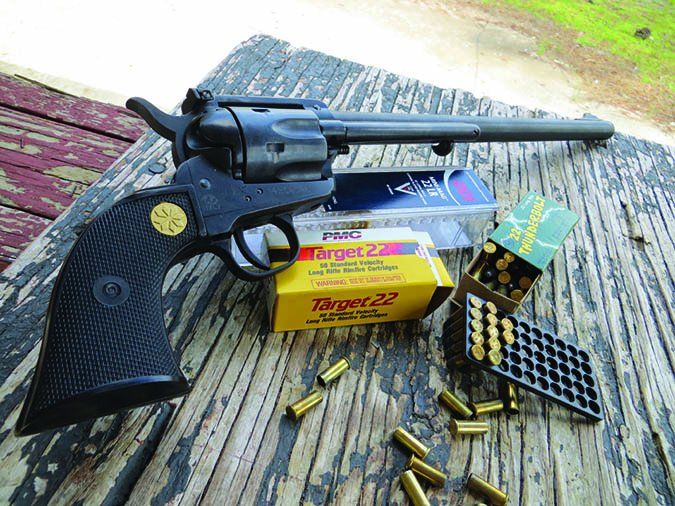
Most gun owners want firearms they can shoot and have fun with, even their life-and-death carry guns. Some of us also want the unusual because we like a walk on the wild side, irrespective of whether it has any use beyond messing around with or plinking. In this Special Report, we take a look at three wheelguns for which there are little or no match ups to find, so head-to-head testing isn’t possible. But even without something to shoot beside them, we can learn plenty about whether some unique, or nearly unique, handguns are worth the time and trouble to find and add to your collection as a real, firing item.
Herewith then, we look at the Nagant M1895 7.62x38mmR, the Smith & Wesson Model 929 9mm Luger, and the Chiappa Buntline 22 LR.
Nagant M1895 7.62x38mmR, $200-$400
GUN TESTS GRADE: B-
The M1895 is a old-world revolver that offers a unique design and fires an equally unique cartridge. It is a fairly inexpensive collectible, at best.
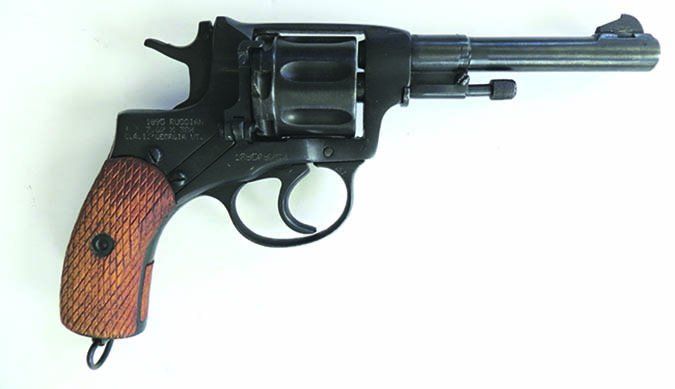
| ACTION TYPE | Double action |
| OVERALL LENGTH | 10.5 in. |
| BARREL LENGTH | 4.5 in. |
| SIGHT RADIUS | 6 in. |
| OVERALL HEIGHT | 5.2 in. |
| MAX WIDTH | 1.5 in. |
| WEIGHT UNLOADED | 16.7 oz. |
| WEIGHT LOADED | 16.9 oz. |
| CYLINDER GAP | N/A |
| CAPACITY | 7 |
| FRAME FINISH | Blued |
| BARREL/CYLINDER FINISH | Blued |
| FRAME FRONT STRAP HEIGHT | 2.4 in. |
| FRAME BACK STRAP HEIGHT | 3.4 in. |
| GRIP | Coarse checkered rose |
| GRIP THICKNESS (max) | 1.2 in. |
| GRIP CIRCUMFERENCE (max) | 4.2 in. |
| FRONT SIGHT | Ramped blade |
| REAR SIGHT | Fixed notch |
| TRIGGER PULL WEIGHT (SA) | 15.4 lbs. |
| TRIGGER PULL WEIGHT (DA) | 6.4 lbs. |
| SAFETY | None |
| WARRANTY | N/A |
| MADE IN | Russia |
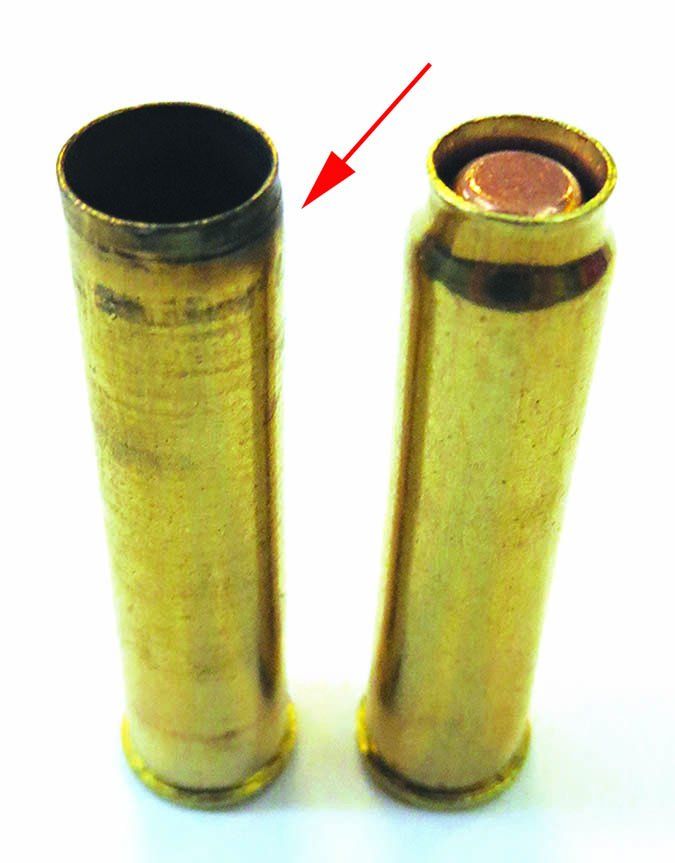
First up is the Nagant M1895 revolver, which first came into service with the Russian Imperial Military in 1895, hence the name, and was used by the Tsar’s Russian Military, as well as with rebels during the Russian Revolution. It also served with Soviet forces in WWII and was manufactured well into the 1950s. This revolver has seen use far and wide in conflicts as old as the Boxer Rebellion and as recent as the Vietnam War. It was still issued early into the 21st century.
7.62mm Nagant Range Data
| HotShot 7.62x38mmR (7.62mm Nagant) 98-gr. FPJ | Nagant M1895 |
| Average velocity | 641 fps |
| Muzzle energy | 89 ft.-lbs. |
| Smallest group | 0.4 in. |
| Average group | 0.5 in. |
| Surplus 7.62x38mmR (7.62mm Nagant) 100-gr. FPJ | |
| Average velocity | 913 fps |
| Muzzle energy | 185 ft.-lbs. |
| Smallest group | 1 in. |
| Average group | 1.1 in. |
| To collect accuracy data, we fired five-shot groups from a bench using a rest. Distance: 15 yards with open sights. We recorded velocities using a ProChrono digital chronograph set 15 feet from the muzzle. | |
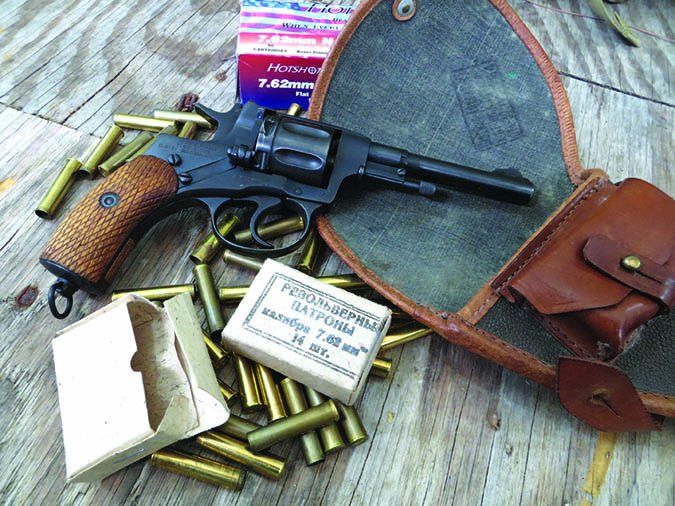
The revolver was designed by Leon Nagant, a Belgium industrialist who, along with his brother Emile, produced everything from firearms to automobiles. Emile co-designed the Mosin-Nagant rifle used by the Imperial Russian troops. The Nagant revolver under various model names and slightly different configurations was in wide use in the late 19th century by military and police forces in countries like Sweden, Poland, Greece, and Norway. The Russian M1895 model was produced in the millions, and we are sure there are still Nagants in nightstand drawers and under pillows back in the Motherland. In the past 20 years, these revolvers were imported into the U.S. by the crate full, making them fairly common at gun shows and online auctions with a cost of about $200 to $400, depending on arsenal markings and condition. Most of these examples have had little to any use.
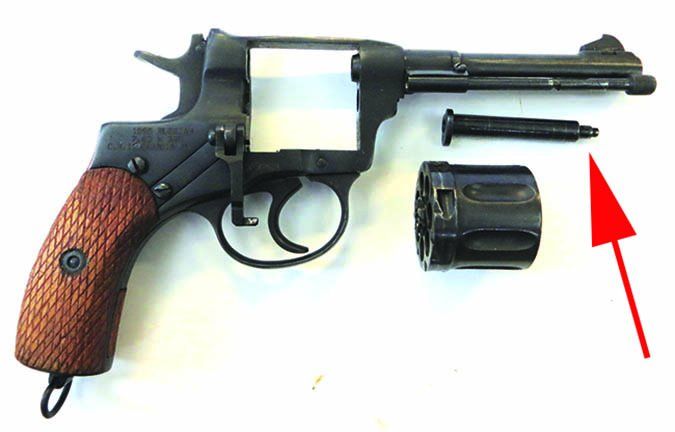
The Nagant revolver is unique in its gas seal. The design helps reduce lost muzzle velocity from the gap between the cylinder and rear of the barrel, a trait of all revolver designs. The Nagant uses a recoil shield to push the cylinder forward. Relief cuts in the cylinder around the front of the chambers allows the cylinder to mate up with the rear of the barrel and forcing cone when the revolver is cocked in SA or in DA use, and in essence, closes the gap to help minimize lost pressure. This translates into better muzzle velocity. The 7.62x38mmR or 7.62mm Nagant cartridge is also unique in that the bullet is seated below the mouth of the cartridge case, and a obvious crimp makes the cartridge look as if it was pinched off at the mouth.
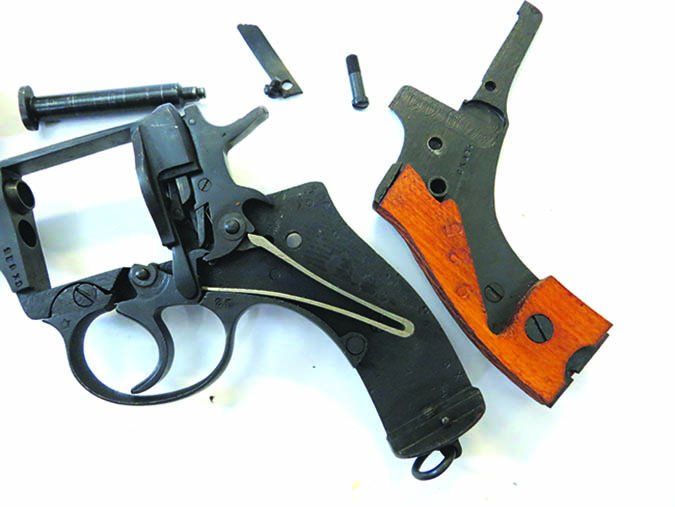
Between the revolver’s cylinder design and the cartridge design, it was discovered muzzle velocity increased up to 75 fps. In American terms, the 7.62x38mmR cartridge has similar energy and muzzle velocity to the 32 S&W Long, which was a popular cartridge back at the turn of the 20th century. The 7.62x38mmR pushes a 98-grain bullet at about 740 fps with a muzzle energy of about 118 foot-pounds. The 32 S&W Long pushes a 97-grain bullet at about 800 fps with a muzzle energy of 138 foot-pounds. The 32 S&W Long was chambered in Smith & Wesson’s Hand Ejector revolver series and in Colt New Police models, both of which saw widespread use at the turn of the 20th century. Importer manuals recommend only firing the 7.62x38mmR round through the M1895.
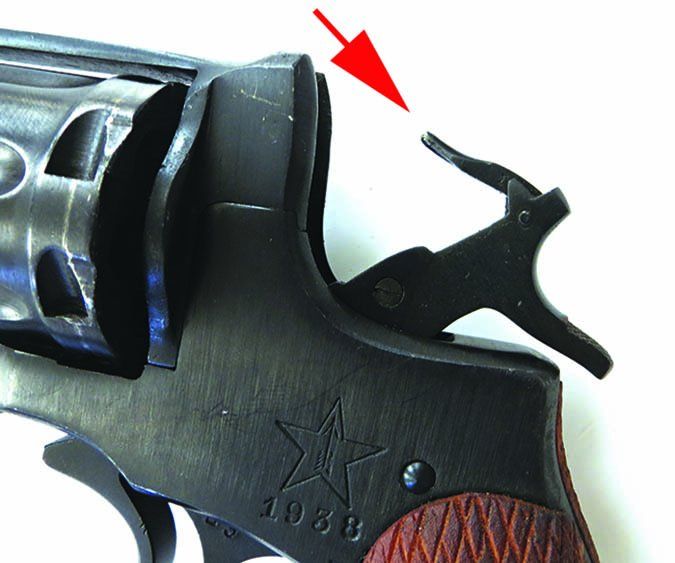
Ammunition is still easily acquired. European ammunition manufacturers like Fiocchi and Prvi Partizan, to name two, manufacture the ammo in 50-round boxes (MidwayUSA.com). We acquired one of these revolvers with a flap holster and cleaning rod as well as surplus and new manufacture ammunition and found these firearms are more relic than revolver.
Since this was a surplus item, we were especially carefully to check the chamber and bore alignment with a 32-caliber range rod (Brownells.com, 080-617-032WB, $39). We found that all chambers were spot on. No need for a gap test due to the M1895 design.
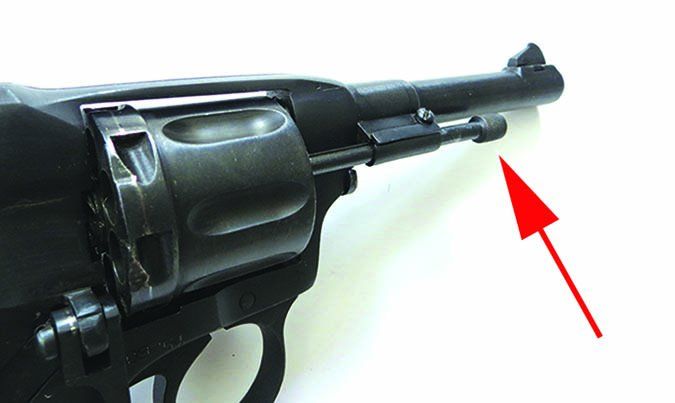
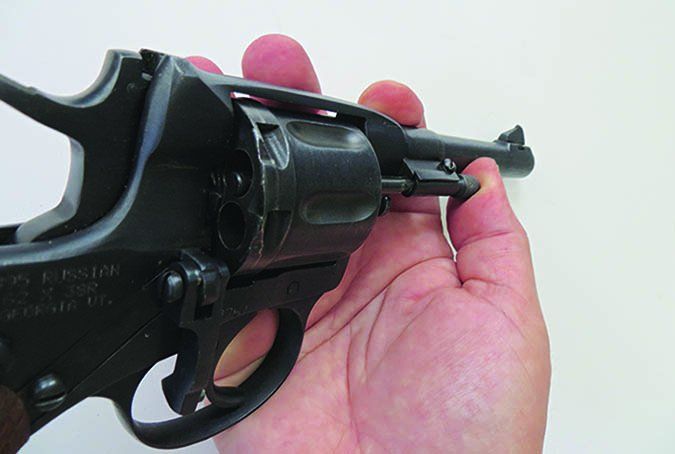
Our specimen had a good blued finish, about what you would expect from a military arsenal and little use. There were no tooling marks. The unfinished wood grips had more of a diamond pattern than checkering, which was done well, better than some modern firearms we’ve reviewed. The lanyard loop was attached to the butt. Ours was marked with a star-with-arrow arsenal stamp and 1938 below, indicating this M1895 was built at the Tula factory in 1938. There were also numerous inspector marks as well as the recent importer markings.
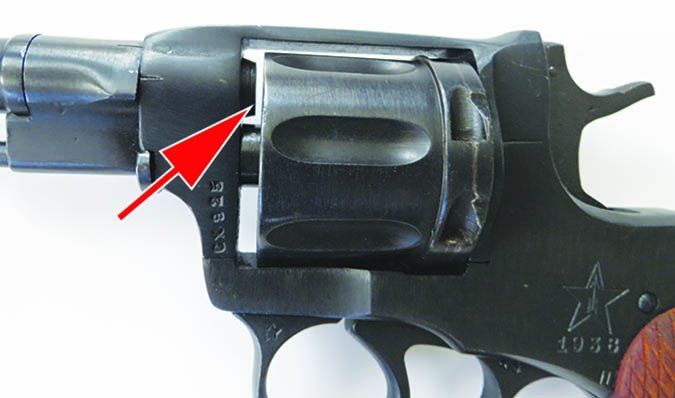
The sights consist of a front blade dovetailed into the barrel. Windage can be adjusted via a hammer and punch. The rear sight is a notch in a built-up area of metal at the top rear of the frame and a groove milled into the top of the frame. Rugged, combat-style sights typical of the late 19th century, we had a hard time finding the tiny blade at times in bright sunlight. To load, the loading gate is swung open, which allows the cylinder to rotate freely clockwise. The trigger can be operated with the loading gate opened. There are no mechanical safeties in the M1895, just common sense. To unload cases, an ejector rod is unscrewed and pivoted to the right side of the frame. The rod can then eject stuck empties. During testing, we found cases typically fell out of the chambers with gravity’s help. This, we surmise, is due to the cartridge/revolver design efficiently using the energy of the round and leaving behind little residue.
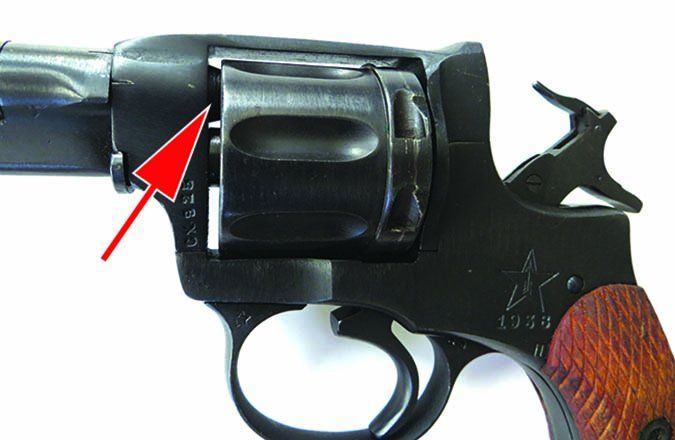
In hand, the grip is short and just fits all fingers of an averaged-size shooter’s hand. The M1895 points well. The mechanism was fairly smooth, not a S&W nor a Colt of the same time period by any means, but okay. The DA trigger pull was well over 15 pounds; in SA it measured about 6 pounds. The DA pull was far too much to be accurate at distances approaching 25 yards unless you had hands like Hercules. It was serviceable at 15 yards. In SA we were surprised to find the M1895 had good accuracy. HotShot ammo gave us a less-than-0.5-inch group with five rounds using a rest and firing SA. Hotter surplus ammo’s best group was just over an inch. Felt recoil was nil due to the cartridge.
Our Team Said: The Nagant is an interesting piece of military history. By today’s standards, the cartridge is obsolete and weak as a defensive round, but the revolver could work as a defensive gun in a pinch. We would buy one only for its place in military history and unique mechanism and cartridge and plink with it when we were feeling nostalgic.
Smith & Wesson Performance Center Model 929 170341 9mm Luger, $1189
GUN TESTS GRADE: A
The Model 929 offered all the bells and whistles one would expect in a S&W Performance Center competition revolver.
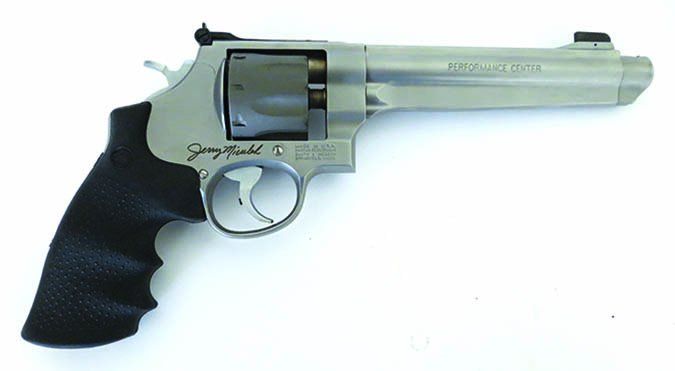
| ACTION | Double action |
| OVERALL LENGTH | 12.25 in. |
| OVERALL HEIGHT | 6 in. |
| MAX WIDTH | 1.7 in. |
| WEIGHT UNLOADED | 44.2 oz. |
| WEIGHT LOADED | 47.4 oz. |
| CYLINDER GAP | 0.006 in. |
| BARREL LENGTH | 6.5 in. |
| CAPACITY | 8 |
| CYLINDER MATERIAL/FINISH | Titanium/matte gray |
| FRAME MATERIAL/FINISH | Stainless steel/matte stainless |
| FRAME FRONT STRAP HEIGHT | 2.2 in. |
| FRAME BACK STRAP HEIGHT | 4.3 in. |
| GRIPS | Textured synthetic, finger grooves |
| GRIP THICKNESS (max) | 1.2 in. |
| GRIP CIRCUMFERENCE (max) | 5.3 in. |
| FRONT SIGHT | Patridge blade |
| REAR SIGHT | Adjustable notch |
| SIGHT RADIUS | 7.3 in. |
| TRIGGER PULL WEIGHT (SA) | 4.3 lbs. |
| TRIGGER PULL WEIGHT (DA) | 10.7 lbs. |
| TRIGGER SPAN (SA) | 2.6 in. |
| TRIGGER SPAN (DA) | 3.1 in. |
| SAFETY | None |
| WARRANTY | 1 year limited |
| TELEPHONE | (800) 331-0852 |
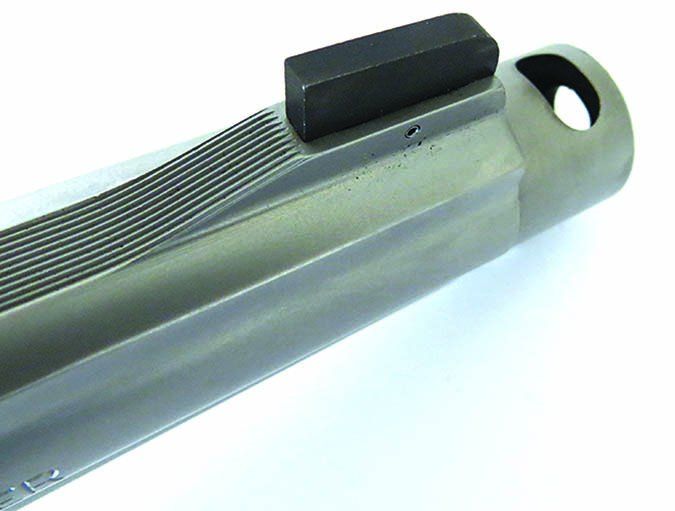
The next gun could not be more different from the Nagant. The M929 is a new 8-shot 9mm all-stainless-steel N-Frame revolver designed from the grip up for action pistol competition, and it comes with the Jerry Miculek signature. For the record, Jerry made a 1,000-yard shot with the 929 on an episode of Shootout Lane.
9mm Luger Smith & Wesson 929 Range Data
| Hornady Steel Match 9mm Luger 115-gr. HAP | Smith & Wesson Model 929 |
| Average velocity | 1180 fps |
| Muzzle energy | 356 ft.-lbs. |
| Smallest group | 0.44 in. |
| Average group | 0.49 in. |
| Winchester White Box 9mm Luger 115-gr. FMJ | |
| Average velocity | 1117 fps |
| Muzzle energy | 319 ft.-lbs. |
| Smallest group | 0.38 in. |
| Average group | 0.67 in. |
| Atlanta Arms 9mm Luger 147-gr. FMJ | |
| Average velocity | 854 fps |
| Muzzle energy | 283 ft.-lbs. |
| Smallest group | 0.25 in. |
| Average group | 0.35 in. |
| To collect accuracy data, we fired five-shot groups from a bench using a rest. Distance: 15 yards with open sights. We recorded velocities using a ProChrono digital chronograph set 15 feet from the muzzle. | |
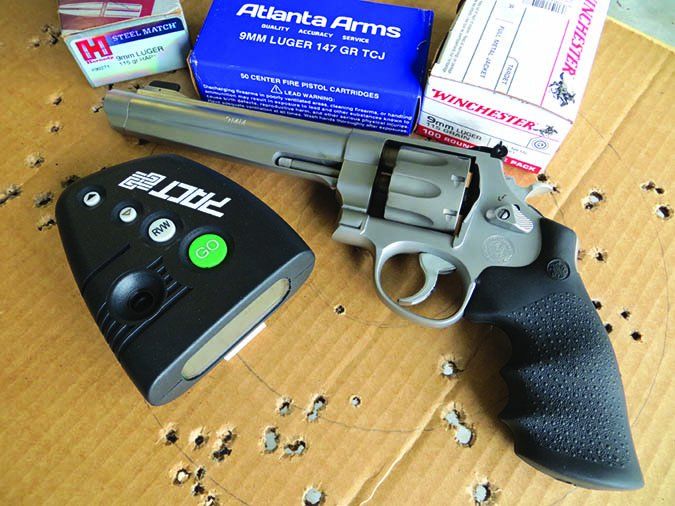
When it comes to serious revolver competition shooting, the type you will find at Bianchi Cup, U.S. Practical Shooting Association (USPSA), International Practical Shooting Confederation (IPSC), International Confederation of Revolver Enthusiasts (ICORE), and Steel Challenge, the top dog has been the Smith & Wesson Model 625 in 45 ACP (we reviewed one last year and gave it an A-), in the Revolver Major division, while the S&W Model 627, in 38 Spl/357 Mag., is popular in Revolver Minor. The S&W Model 929 is a new competitor designed to compete in Revolver minor.
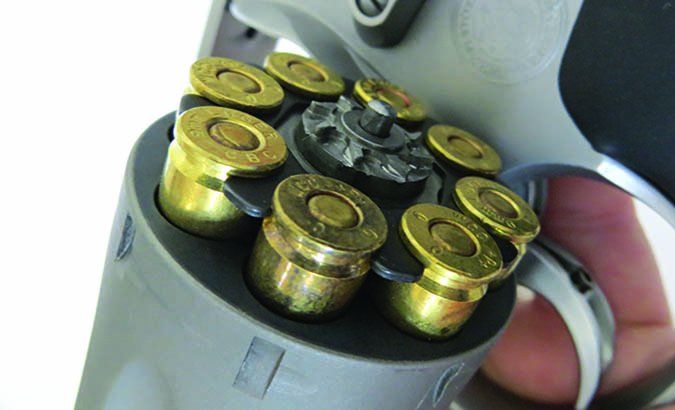
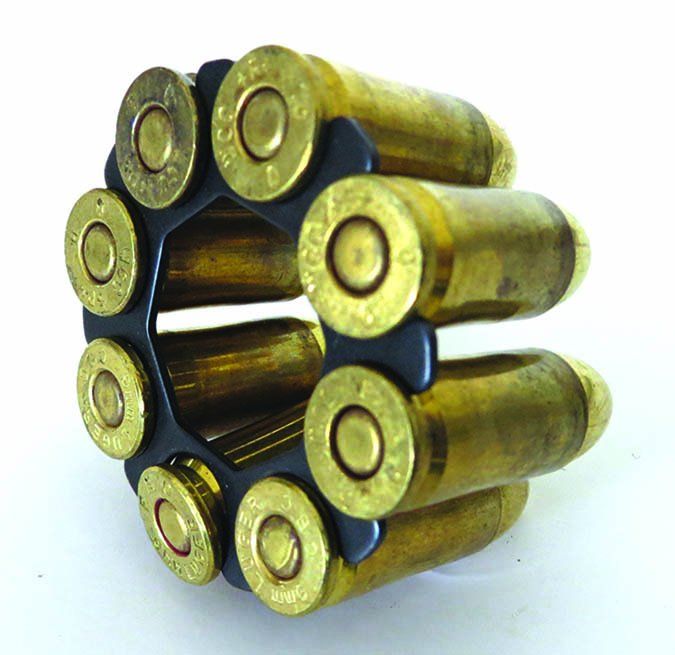
A recent change in USPSA Revolver Division was the addition of an 8-shot minor category, making revolver mirror Single Stack Division somewhat. Competitors in Revolver Division can choose to shoot Major power factor (PF), in which case they must reload after 6 shots, or Minor PF, in which case they must reload after 8 shots. Some competitors opt for more rounds before the reload, trading points for non-A hits for time saved reloading. This is just one of the sweet spots we saw right off the bat for the S&W Model 929 revolver, since this revolver is unique. We looked at the 929 for exactly what it was designed for, a revolver dedicated for competition and, as such, will appeal nearly exclusively to that segment of competitive shooters.
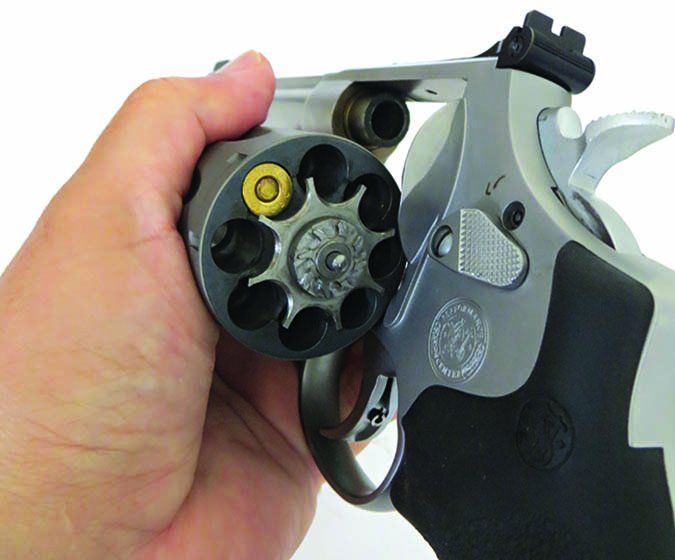
Without getting too deep into the weeds of competitive revolver shooting, we do think a bit of revolver strategy will help put this revolver into perspective. Continuing with USPSA competition, let’s take a quick look at strategy. Target arrays or groups are basically limited to 8 rounds required per group, with course design making room for reloads and movement. With a 6-shot revolver, this will require extra reloading, unless the course is set up to be 6-shot neutral. In addition, having to reload after 6 shots causes the competitors to do a lot more strategic planning regarding which targets to shoot and where to shoot them from. With an 8-shot revolver, there is more freedom to engage targets on an “as and when visible” basis, without worrying too much about making additional reloads. So you can see there can be an advantage to an 8-shot revolver, depending on your strategy.
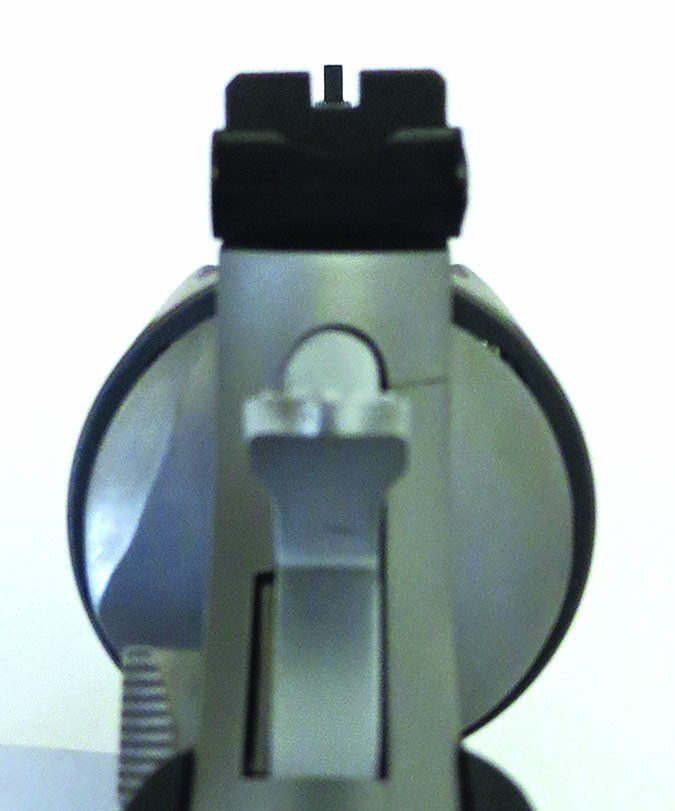
We also looked at 929 as a companion to your 9mm semi-auto pistol, both sharing the same ammo, which is convenient. The 929 offers more target shooting features than the current offerings of 9mm revolvers, which are typically concealed-carry defensive snubnose models.
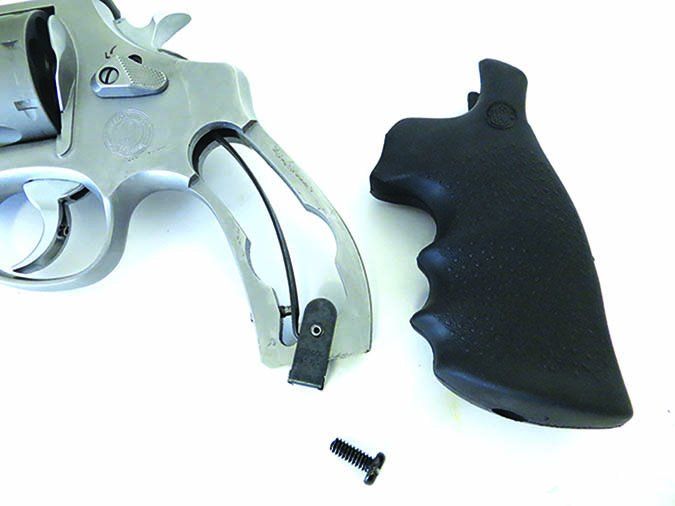
Before any moon clips were loaded, we placed the 929 through our battery of tests and found all the tuning we expected from the Performance Center. This revolver was tight and well made, with no cylinder movement. The cylinder gap was 0.006 inches, which well within spec. Since this is an N-Frame and designed for long cartridges like the 44 Mag., the barrel was screwed deep into the frame, so the 9mm bullets had less free flight in the cylinder before engaging the forcing cone and bore. S&W uses a similar set up on some revolvers chambered in 45 ACP.
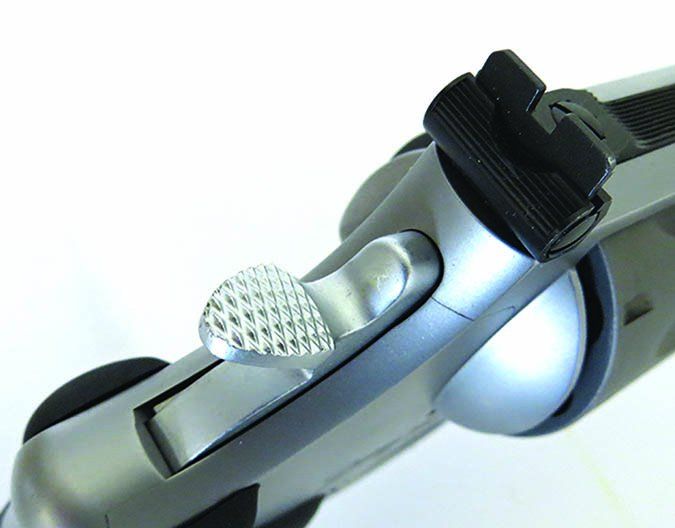
The 929 features a 6.5-inch barrel with a full-length, tapered underlug to help reduce the effects of felt recoil and a compensator to minimize muzzle flip. The compensator can quickly and easily be removed and replaced with a false muzzle. This is a feature we liked since not all revolver competitions are alike, with some divisions not allowing a compensator. On top of the barrel was an adjustable rear sight with a plain, matte-black notch. The front Patridge sight was also matte black. On a black target, these sights did get lost. On cardboard and painted steel, they showed up much better. We liked the fact the front sight was pinned, so it could be replaced with a sight more suited to the user. Under the rear sight, the 929 was drilled and tapped so a reflex or red dot sight could be mounted. Again, depending on the division and type of competition, the ability to mount a sight was a plus. The finish of the frame and barrel was a matte stainless with no glare when used in bright sunlight.
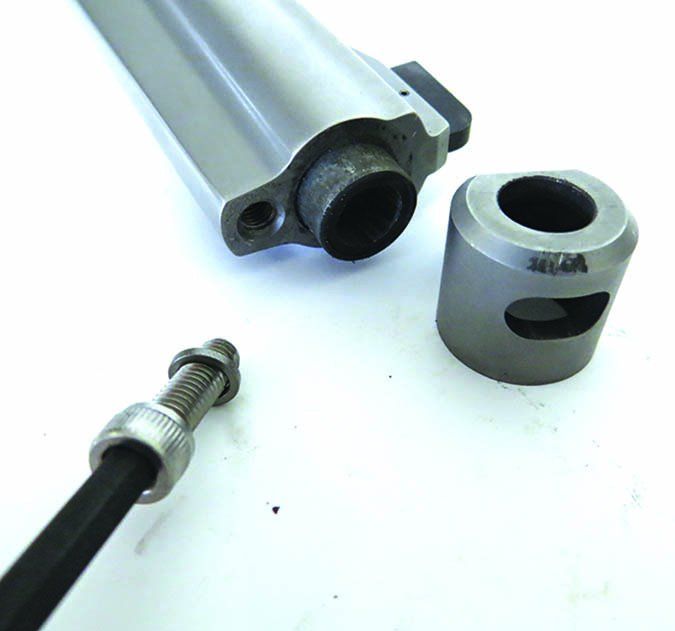
The 8-shot cylinder is constructed of lightweight titanium. The ejector was cut for use with moon clips, and all the chambers were chamfered. Although 9mm cartridges could be loaded into the chambers and fired, the ejector did not shuck them out. A rod was required to eject the case. We doubt competitors would ever load cartridges one at a time, so be sure to have plenty of moon clips on hand. The moon clips were easy to load and unload without the use of a tool. They did not bend as easily as with 45 ACP clips we have used in the past.
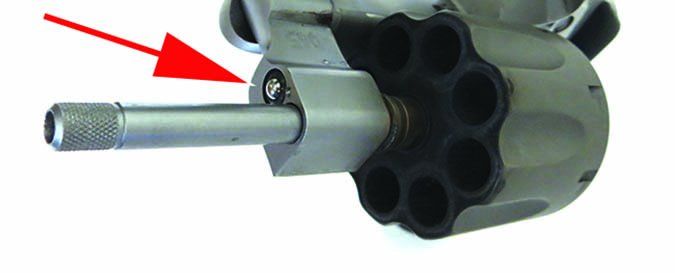
The crane had a ball detent that snapped into a V-shaped groove in the frame. This set up locked up the 929 consistently tight and is a common gunsmithing modification for competition revolvers. The cylinder latch was the type cut for use with a speed loader, and since the 929 uses moon clips, it was out of way and did not impede a fast reload. We did find that it took slightly longer to load this 8-shot revolver compared to a 6-shot 45 ACP revolver because the holes in the cylinder of a 45 ACP are larger, with more space in between chambers.
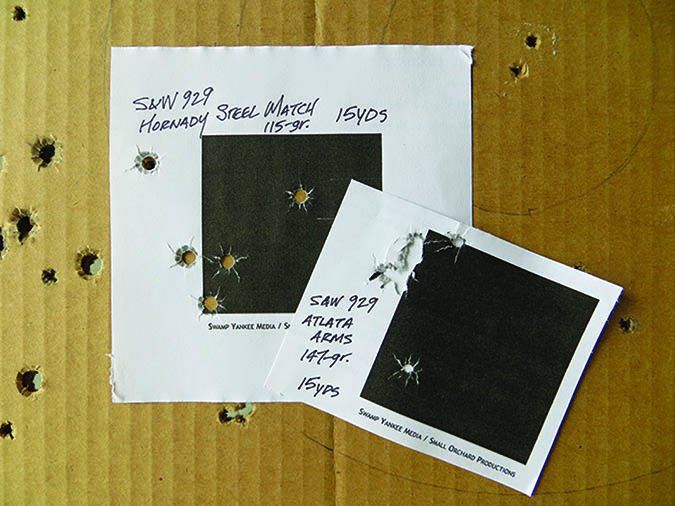
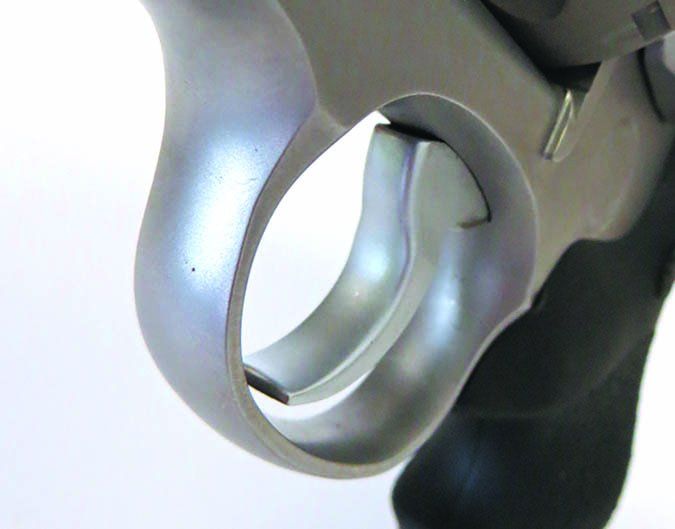
Both the trigger and hammer were chromed plated. The hammer was tear-drop shaped and offered plenty of traction to thumb-cock the 929. The smooth-faced trigger included a trigger stop, which we liked for a competition revolver. The 929 had a nice trigger, what we expected from the Performance Center. In DA mode, the pull seemed less than what it measured at 10.7 pounds.
The grip was typical of a large-frame S&W of late, rubber with finger grooves, which either shooters like or hate. Our group was evenly divided on the grips. Again this is a feature that is easily user modified, but at additional cost.
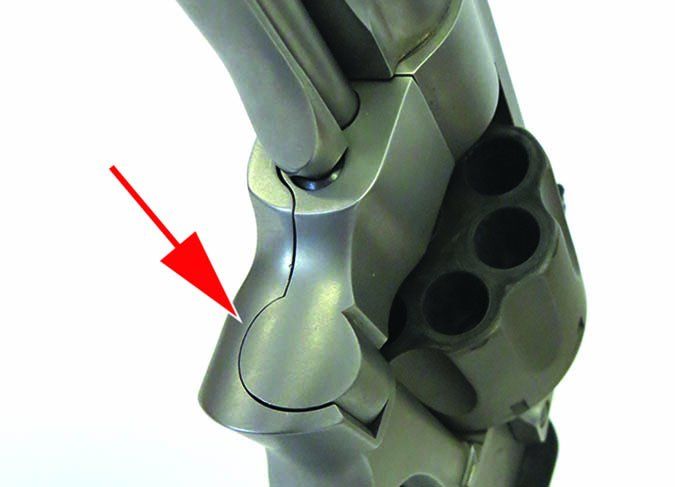
At the range, with an assortment of ammo from Hornady, Winchester, and Atlanta Arms, we started shooting for accuracy using a rest and found the 929 preferred the 147-grain Atlanta Arms ammo, giving us the smallest 5-shot group of the test at 0.25 inches at 15 yards. A target revolver the 929 is, but for fast-paced action shooting. So we moved onto shooting fast at tombstone style NRA D-1 targets set up on P3 target stand from CTK Precision (ctkprecision.com). Our drill was shoot 8 rounds, reload and shoot two more rounds, all while trying to keep hits in the 8-inch A-ring while shooting as fast as we could.
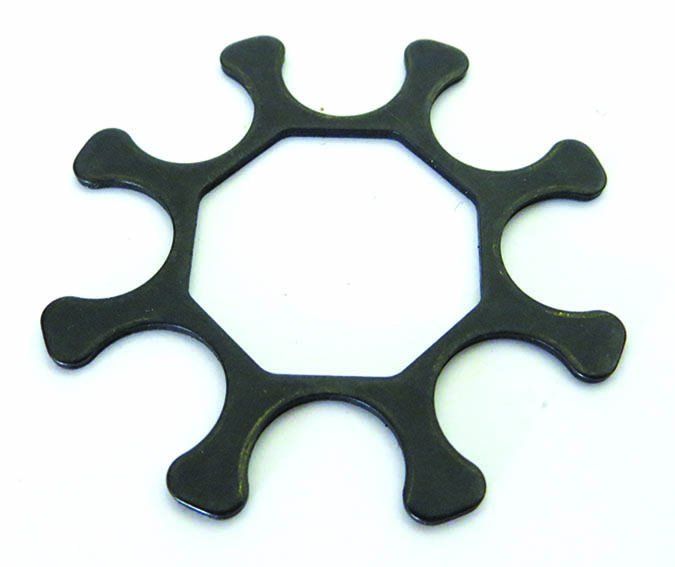
Most shooters found the 929 smooth to shoot, with little felt recoil, even with the heavy 147-grain Atlanta Arms ammo. The 115-grain ammo from Winchester and Hornady was much easier for all shooters to fire fast and accurately. We assume that if this was to be used in competition, the shooter would reload ammo with lightweight bullets to help reduce felt recoil and muzzle rise. The comp provided less muzzle rise in fast DA shooting compared to not using the comp. The hang up we encountered was with the reload. Since the 9mm rounds in the moon clip are small and there are eight of them, it took some time to align the rounds with the chambers. We eventually got the hang of it and our overall time decreased. The cartridges with more of a taper to the bullet loaded a smidgen faster until we got our game on. The grips were definitely too large for some testers, but they tolerated them. They could not get a consistent grip, which slowed them down. Removing the finger grooves would provide a better universal grip, we believe. The trigger was excellent, with no stacking, smooth and consistent throughout the pull—again, what we expect from the Performance Shop. Overall, the revolver was fast on target, had a smooth DA trigger pull, and provided enough heft to dampen felt recoil.

Our Team Said: The 929 is a unique revolver, and if we were looking for a revolver for action shooting competition, we would consider the 929. As a sunny-day plinking revolver, we think it is overqualified and overpriced for that role.
Chiappa 1873 SAA 22 Buntline, Model: SAA1873-22, 22 LR, $339
GUN TESTS GRADE: A
The Buntline offered all we expected in a rimfire Buntline plus a reasonable price.
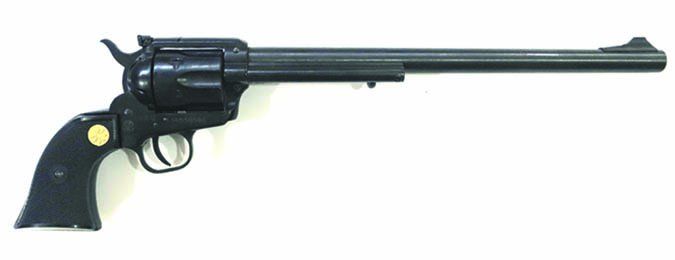
| ACTION | Single |
| OVERALL LENGTH | 19.9 in. |
| OVERALL HEIGHT | 5.2 in. |
| MAX WIDTH | 1.6 in. |
| WEIGHT UNLOADED | 44.8 oz. |
| WEIGHT LOADED | 48.8 oz. |
| CYLINDER GAP | 0.010 in. |
| BARREL LENGTH | 12 in. |
| CAPACITY | 6 |
| FRAME MATERIAL/FINISH | Zamak alloy/matte black |
| CYLINDER MATERIAL/FINISH | Steel/matte black |
| FRAME FRONT STRAP HEIGHT | 2.1 in. |
| FRAME BACK STRAP HEIGHT | 3 in. |
| GRIPS | Checkered plastic |
| GRIP THICKNESS (max) | 1.5 in. |
| GRIP CIRCUMFERENCE (max) | 5.7 in. |
| FRONT SIGHT | Ramp blade |
| REAR SIGHT | Adjustable notch |
| SIGHT RADIUS | 13.3 in. |
| TRIGGER PULL WEIGHT (SA) | 3.3 lbs. |
| TRIGGER SPAN (SA) | 2.8 in. |
| SAFETY | None |
| WARRANTY | 1 year |
| TELEPHONE | (937) 835-5000 |
| WEBSITE | ChiappaFirearms.com |
Our third revolver is manufactured by Chiappa in Italy and is part of a line of single-action rimfire revolvers called the 1873 SAA 22 series. One has a foot-long barrel and is named the 1873 SAA 22 Buntline.
22 LR Chiappa Buntline Range Data
| Remington Thunderbolt 22 Long Rifle 40-gr. RNS | Chiappa Buntline |
| Average velocity | 914 fps |
| Muzzle energy | 74 ft.-lbs. |
| Smallest group | 0.6 in. |
| Average group | 1.7 in. |
| PMC Target 22 Long Rifle 40-gr. RNS | |
| Average velocity | 879 fps |
| Muzzle energy | 69 ft.-lbs. |
| Smallest group | 0.2 in. |
| Average group | 0.6 in. |
| CCI Mini-Mag 22 Long Rifle 40-gr. RNS | |
| Average velocity | 1034 fps |
| Muzzle energy | 95 ft.-lbs. |
| Smallest group | 0.5 in. |
| Average group | 1 in. |
| To collect accuracy data, we fired five-shot groups from a bench using a rest. Distance: 15 yards with open sights. We recorded velocities using a ProChrono digital chronograph set 15 feet from the muzzle. | |
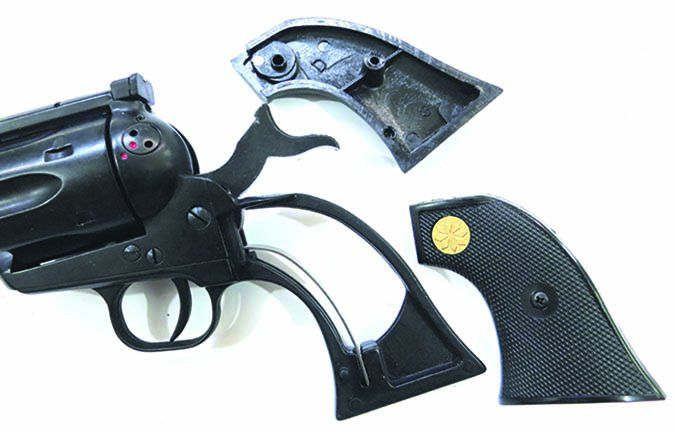
We used a range rod to check the chamber alignment of all chambers to the bore with a range rod. The cylinder-to-barrel gap was a tad over spec at .010 inches on the Chiappa, and we thought we would experience a louder blast and might feel it on our shooting hand. We did not expect any splatter because the chamber-to-bore alignment was good. The Chiappa cylinder had very little front-to-back and up-and-down play.
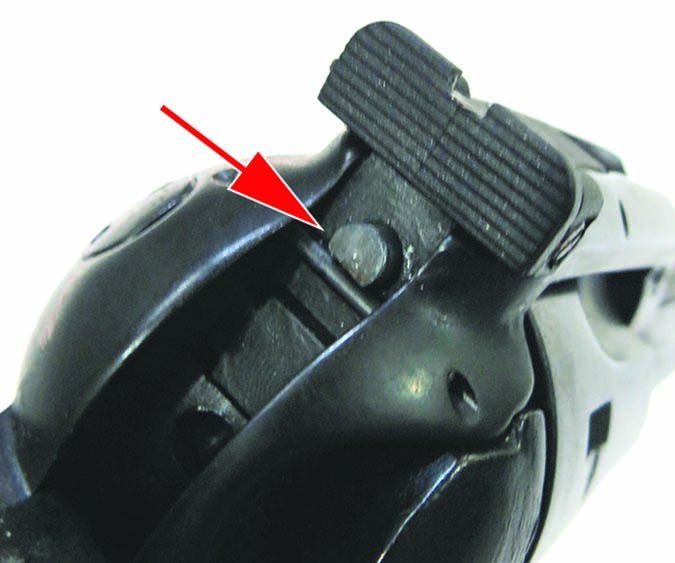
The Buntline has a substantial feel in hand. It felt solid and slightly smaller than a traditional centerfire SAA. The hammer cocked back with three distinct clicks, and the hammer came back quite far. A meaty-handed shooter might get the web of his hand pinched between the hammer and backstrap, but our testers had no issues. The hammer had good checkering on the spur. We had no thumb slips during range time. When we removed the grip, we found a traditional flat main spring. Cocking was smooth and easy. Not a lot of thumb strength was required.
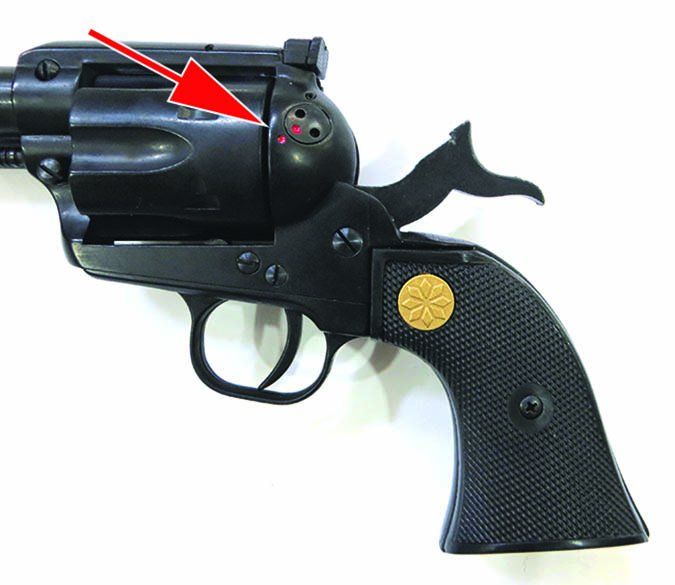
The barrel was heavy and made of steel like the fluted cylinder. The frame and one-piece grip were made of Zamak alloy, which is a combination of zinc and aluminum. Many die-cast metal parts are made from this alloy. The entire revolver wore a matte-black finish that was done nicely. The finish did not wear, even on the sharp edges, during testing. The grips were checkered plastic with an inset brass emblem that was tastefully done. The grips overlapped the frame by about 0.125 inches but blended smoothly along the front and rear grip straps. Some daylight could be seen between the ejector housing and barrel. Overall, testers thought the Buntline was well made for the price.
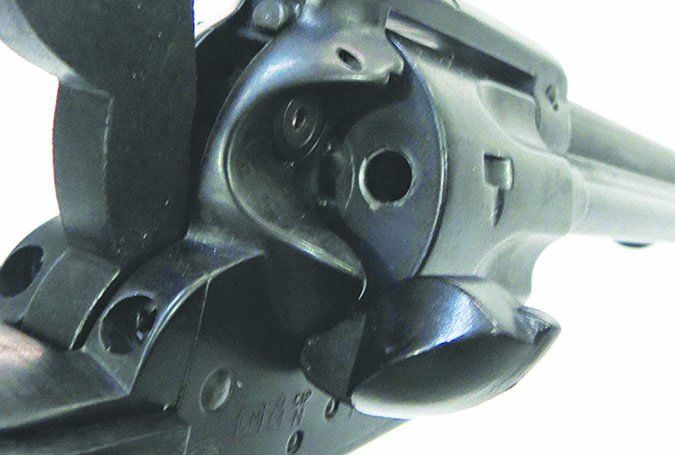
The Buntline operated much like a traditional SAA. Place the hammer on half cock, open the loading gate to load each chamber. There was plenty of wiggle room to load a cartridge, even if you went a bit too far rotating the cylinder. If this revolver is to be carried loaded, the hammer should rest on an empty chamber. The firing pin is built into the frame. There is a safety lock that blocks the hammer from contacting the firing pin. A key is used to rotate the lock into place. While in lock mode, the revolver can still be loaded and unloaded and the hammer snapped, but it will not contact the firing pin. This is a lock one might use when storing the revolver.
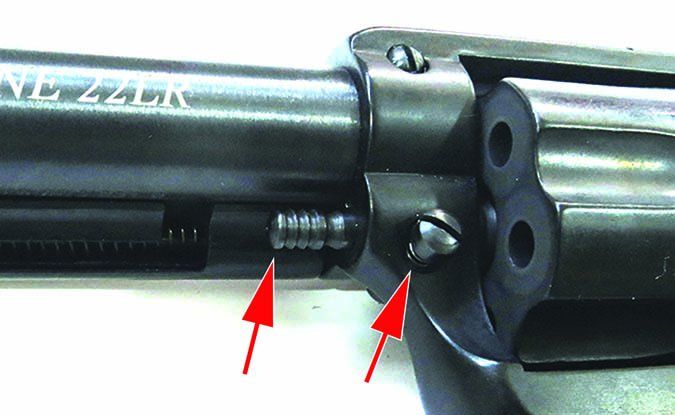
The skinny trigger had noticeable creep before it broke at a little over 3 pounds on average. The break was consistently crisp, and as some of our accuracy data shows, the Buntline was a straight shooter. The ejector-rod head was crescent shaped and rotated away from the barrel, which is a good thing as the barrel heated.
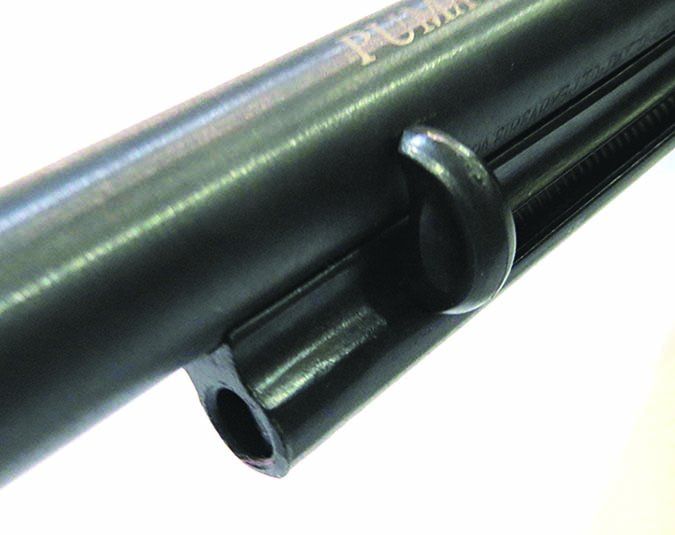
The sights consisted of a plastic ramp front that was plenty rugged and screwed to the barrel. The rear adjustable sight was also plastic and also rugged. The sight was marked so you knew if you were raising or lowering the notch or going left or right. This is a nice feature we’ve come to expect on revolver sights. The surface of the rear sight that faced the shooter was serrated to cut glare, another nice feature.
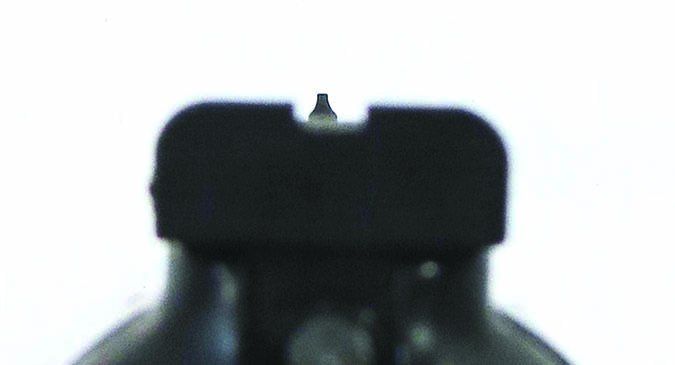
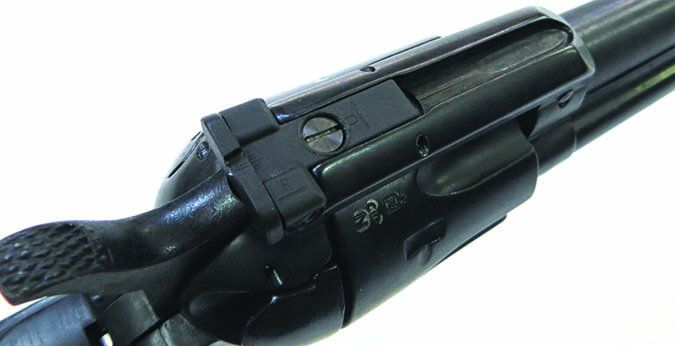
To field strip, the hammer is put on half cock, the loading gate opened, and the basepin button pushed to withdraw the cylinder rod. The cylinder then falls out of the loading-gate side of the frame. The cylinder had a removable bushing like a traditional centerfire SAA. We thought the bushing was not needed on a rimfire revolver since the bushing was traditionally used to combat fouling from black-powder cartridges. Rimfire cartridges can be messy to shoot, so the bushing does have some value, especially if the revolver is not frequently cleaned. We had no issues with fouling, even with the boxes of ammo we put through the Buntline.
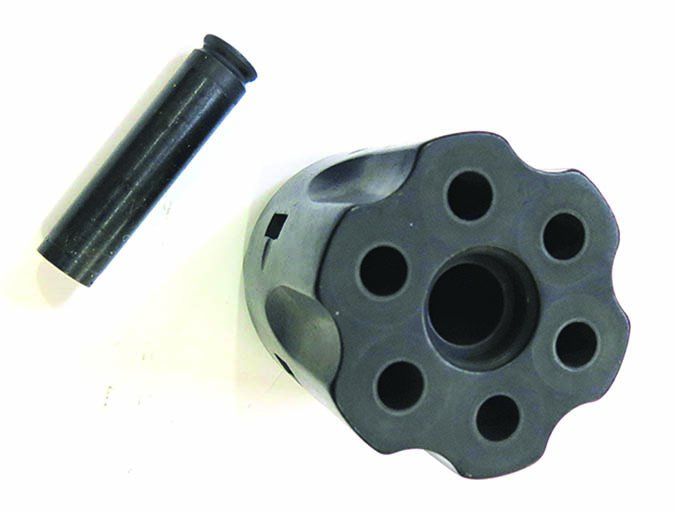
At the range with PMC Target ammo, we were able to get groups that consisted of one ragged hole. The barrel length moved the muzzle blast away from the shooter, and we did not experience any excessive blast due the cylinder gap. The sights were easy to use, though black sights on a black target can mean the sights might momentarily get lost when aiming. We had no issues with the Chiappa. Unloading this rimfire revolver can be tedious if the cylinder is rotated too far, but the Chiappa’s cylinder had plenty of rotation back and forth before a new chamber was exposed, so inserting the ejection rod in the chamber was a simple task.
Our Team Said: The Chiappa Buntline was a well-made revolver that was fun to shoot. With long sight radius, this revolver would be good for a novice shooter. Most felt it was a dedicated plinker because the barrel was much too long to tote on the trail. With a shoulder holster, this could be a great hunter for small game.
Written and photographed by Robert Sadowski, using evaluations from Gun Tests team testers.



























